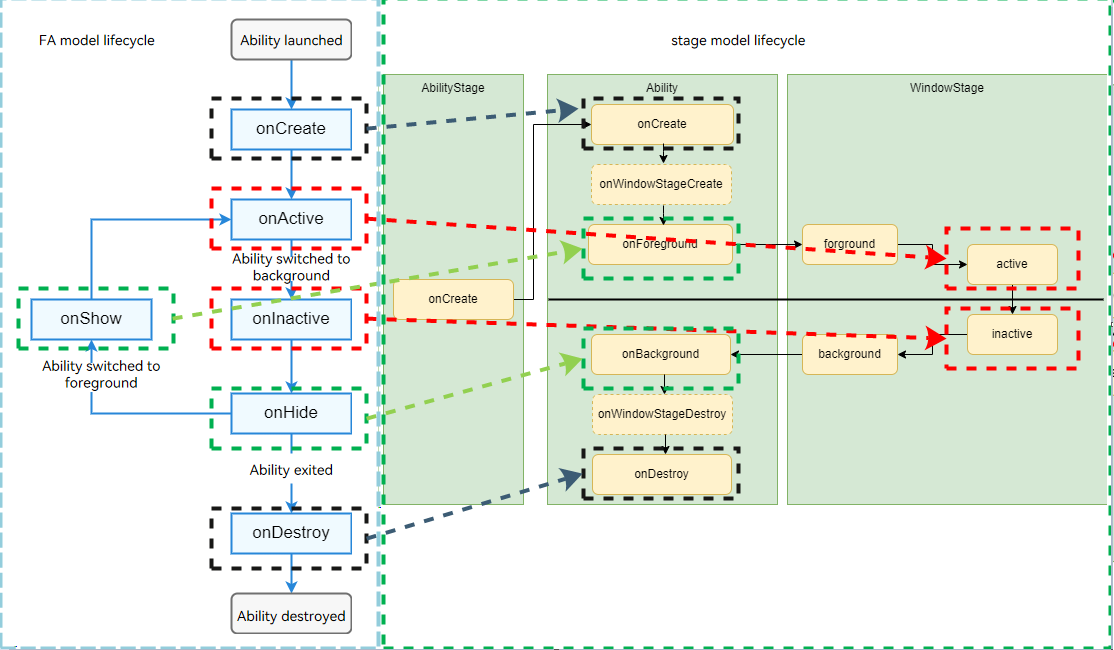harmony 鸿蒙PageAbility Switching
PageAbility Switching
The PageAbility component in the FA model corresponds to the UIAbility component in the stage model. To switch a PageAbility to a UIAbility, perform the following operations:
Create a UIAbility in the stage model.
Migrate the PageAbility code to the UIAbility.
The PageAbility lifecycle is basically the same as the UIAbility lifecycle. The table below describes the details.
|PageAbility|UIAbility|Mapping Description|
|——–|——–|——–|
|onCreate(): void|onCreate(want: Want, launchParam: AbilityConstant.LaunchParam): void|The two methods have the same meaning and invoking time. In the stage model, parameters are added to the callback so that you can obtain startup-related data during creation.|
|NA|onWindowStageCreate(windowStage: window.WindowStage): void|This method is available only in the stage model. The callback is invoked when a window is created.|
|onActive(): void|on(eventType: ‘windowStageEvent’, callback: Callback<WindowStageEventType>): void;
WindowStageEventType.ACTIVE|The two methods have the same meaning and invoking time. In the stage model, this method is moved to the window object.|
|onShow(): void|onForeground(): void|The two methods have the same meaning, invoking time, and parameters.|
|onNewWant(want: Want): void|onNewWant(want: Want, launchParam: AbilityConstant.LaunchParam): void|The two methods have the same meaning and invoking time. In the stage model, the LaunchParam parameter is added to notify the application of the startup cause.|
|onInactive(): void|on(eventType: ‘windowStageEvent’, callback: Callback<WindowStageEventType>): void;
WindowStageEventType.INACTIVE|The two methods have the same meaning and invoking time. In the stage model, this method is moved to the window object.|
|onHide(): void|onBackground(): void|The two methods have the same meaning, invoking time, and parameters.|
|NA|onWindowStageDestroy(): void|This method is available only in the stage model. The callback is invoked when a window is destroyed.|
|onDestroy(): void|onDestroy(): void|The two methods have the same meaning, invoking time, and parameters.|

Adjust the migrated code, since the methods of loading pages are different.
- In the FA model, page loading is configured by setting page information in config.json.
- In the stage model, page loading is triggered through windowStage.loadContent in the onWindowStageCreate callback.
The following uses the task of displaying the pages/Index page after the ability is started as an example. In the FA model, add the following code in the config.json file:
```json
"pages" : [
"pages/Index"
]
```
In the stage model, implement the following API in MainAbility:
```ts
import { UIAbility } from '@kit.AbilityKit';
import { hilog } from '@kit.PerformanceAnalysisKit';
import { window } from '@kit.ArkUI';
export default class TestAbility extends UIAbility {
// ...
onWindowStageCreate(windowStage: window.WindowStage) {
hilog.info(0x0000, 'testTag', '%{public}s', 'TestAbility onWindowStageCreate');
windowStage.loadContent('testability/pages/Index', (err, data) => {
if (err.code) {
hilog.error(0x0000, 'testTag', 'Failed to load the content. Cause: %{public}s', JSON.stringify(err) ?? '');
return;
}
hilog.info(0x0000, 'testTag', 'Succeeded in loading the content. Data: %{public}s',
JSON.stringify(data) ?? '');
});
}
// ...
}
```
Then configure the page to load in the resources/base/profile/main_pages.json file.
```json
{
"src": [
"pages/Index"
]
}
```
你可能感兴趣的鸿蒙文章
harmony 鸿蒙Obtaining Reasons for Abnormal Application Exits
harmony 鸿蒙UIAbility Backup and Restore
harmony 鸿蒙Using Explicit Want to Start an Application Component
harmony 鸿蒙Introduction to Ability Kit
harmony 鸿蒙AbilityStage Component Container
harmony 鸿蒙Accessing a DataAbility
harmony 鸿蒙Accessing a DataShareExtensionAbility from the FA Model
harmony 鸿蒙Common action and entities Values (Not Recommended)
- 所属分类: 后端技术
- 本文标签: